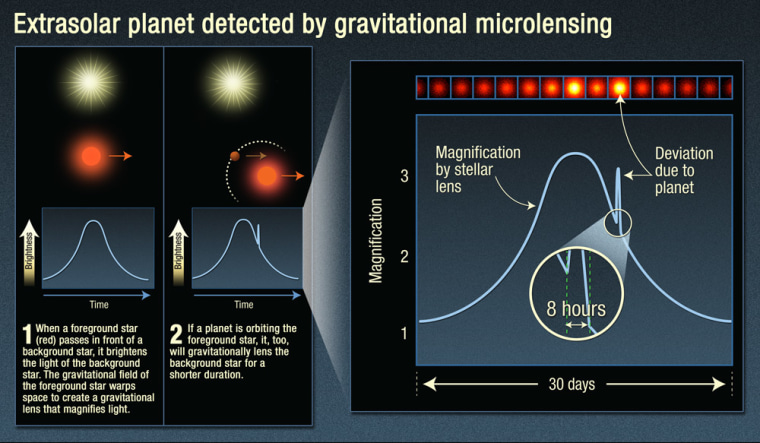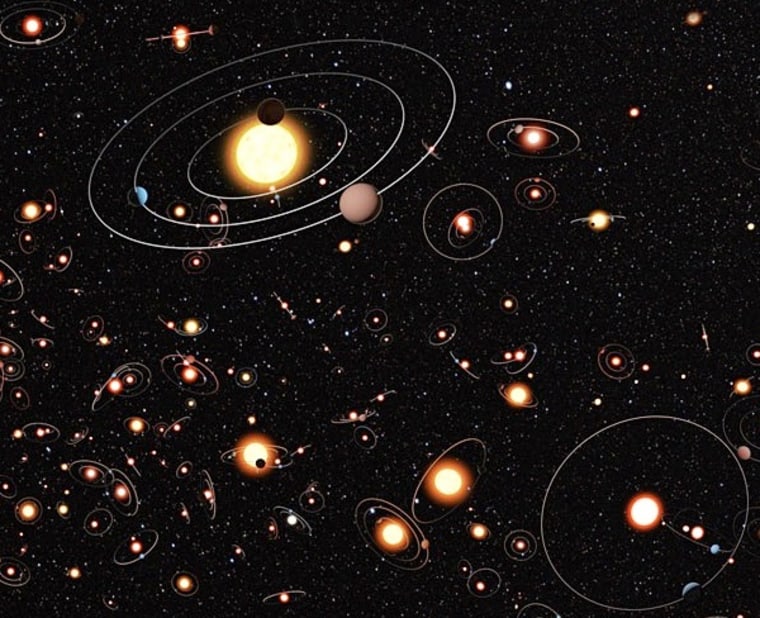A statistical analysis based on a survey of millions of stars suggests that there's at least one planet for every star in the sky, and probably more. That would add up to 160 billion planets or so in the Milky Way.
"We conclude that stars are orbited by planets as a rule, rather than the exception," an international research team reports today in the journal Nature.
The estimate may sound amazing: Just a year ago, the world was wowed by the claim that at least half of the 100 billion or more stars in the Milky Way possessed planets, yielding a figure of 50 billion planets. The latest survey now suggests that there's an average of 1.6 planets per star system, which would work out to 160 billion. But perhaps the most amazing thing about the findings is ... astronomers don't find them amazing at all.
"I am not surprised by the numbers," Didier Queloz, a planet-hunter at the Geneva Observatory who was not involved in the survey, told me in an email. Back in 2008, Queloz was part of a different research team that concluded one-third of the stars like our sun harbored super-Earth-size planets — the kinds of planets that could support life.
Over the past couple of years, findings from a variety of planet-hunting missions — including NASA's Kepler space telescope, the European Space Agency's COROT telescope and ground-based telescope surveys — have reinforced the view that planets are plentiful.
"Results from the three main techniques of planet detection are rapidly converging to a common result: Not only are planets common in the galaxy, but there are more small planets than large ones," Caltech astronomer Stephen Kane, a member of the team behind the findings reported in Nature, said in a news release from the Space Telescope Science Institute. "This is encouraging news for investigations into habitable planets."
Six years' worth of data
The new findings draw upon six years' worth of data from two wide-field surveys known as PLANET and OGLE. These surveys use a network of telescopes around the world, scanning the night sky for very rare events in which the light from one star system is amplified by the gravitational-lensing effect of another star (and perhaps a planet) passing in front of it. This particular planet-hunting method is known as microlensing, as opposed to the transit method (which looks for telltale dips in starlight as a planet crosses its parent star's disk) or the radial-velocity method (which looks for the slight gravitational wobble in a star that has a planet in orbit).

During their six years of searching, the microlensing researchers identified only three actual planets. But they combined those detections with seven earlier detections, plus all the data about non-detections, to arrive at an estimate of how probable it is that planets of different types would be found around a star.
They estimated that about 17 percent of the stars in the Milky Way should host planets in the Jupiter range (0.3 to 10 times as massive as Jupiter), 52 percent should have planets in the Neptune range (10 to 30 times Earth's mass), and 62 percent should have super-Earth-size planets (five to 10 times Earth's mass).
All these figures are surrounded by wide bands of uncertainty. For example, the researchers say their estimate of 1.6 planets per star system could actually be anywhere between 0.7 and 2.5. But the lead author of the Nature study told me that his team's estimate is the best guess yet.
"The average number we find is higher than estimates derived by other methods," said Arnaud Cassan, an astronomer at the Institut d'Astrophysique de Paris. That's because the microlensing method can detect planets as small as five times Earth's mass up to 10 times Jupiter's mass, in orbits ranging from 0.5 to 10 times as wide as Earth's. Other methods aren't that sensitive, Cassan said.
"If they could detect planets with a range farther out, our guess is that they would find more planets," Cassan said.
What are the chances?
The big issue would have to do with how precise the statistical analysis can be with such a small sample of actual detections. Microlensing events are so rare that coming upon even one is like winning the lottery, and that makes the numbers difficult to crunch. But after reviewing the Nature paper, Queloz told me that Cassan and his colleagues conducted "a very good statistical analysis of the microlensing surveys."
Whether the actual number of planets in the Milky Way is 70 billion or 250 billion, it's a big, big number — 10 to 30 planets for every human on Earth. And the number doesn't even count worlds that are less than five times as big as Earth (such as Mercury, Venus, Mars and our own planetary home), inside the orbit of Venus or beyond the orbit of Saturn (such as Uranus, Neptune and the icy dwarfs on the solar system's edge).
Still more revelations about planets beyond our own solar system are coming up this week, but the bottom line for all this is that there's a big cosmos out there — with plenty of opportunities for planets and even life to develop. And that'll always be amazing.
"We used to think that the Earth might be unique in our galaxy," Daniel Kubas, a colleague of Cassan's at the Institut d'Astrophysique de Paris and a co-author of the Nature paper, said in a news release from the European Southern Observatory. "But now it seems that there are literally billions of planets with masses similar to Earth orbiting stars in the Milky Way."
More about the planet quest:
- Three newfound worlds are smaller than Earth
- Flash interactive: How other worlds are found
- Two new 'Tatooine' planets with two suns
- SETI researchers check signals in exoplanet study
- Microlensing turns up rocky, low-mass world
- Cosmic Log archive on planets
In addition to Cassan, Kubas and Kane, authors of the Nature paper, "One or More Bound Planets Per Milky Way Star from Microlensing Observations," include J.-P. Beaulieu, M. Dominik, K. Horne, J. Greenhill, J. Wambsganss, J. Menzies, A. Williams, U. G. Jørgensen, A. Udalski, D.P. Bennett, M.D. Albrow, V. Batista, S. Brillant, J.A.R. Caldwell, A. Cole, Ch. Coutures, K.H. Cook, S. Dieters, D. Dominis Prester, J. Donatowicz, P. Fouqué, K. Hill, N. Kains, J.-B. Marquette, R. Martin, K.R. Pollard, K.C. Sahu, C. Vinter, D. Warren, B. Watson, M. Zub, T. Sumi, M.K. Szymanski, M. Kubiak, R. Poleski, I. Soszynski, K. Ulaczyk, G. Pietrzynski and L. Wyrzykowski.
Alan Boyle is msnbc.com's science editor. Connect with the Cosmic Log community by "liking" the log's Facebook page, following @b0yle on Twitter and adding the Cosmic Log page to your Google+ presence. You can also check out "The Case for Pluto," my book about the controversial dwarf planet and the search for new worlds.
